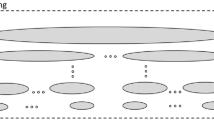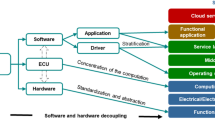Abstract
Over the past decade, a dramatic increase of functionality, quantity, size, and complexity of software-intensive embedded systems in the automotive industry can be observed. In particular, the growing complexity drives current requirements engineering practices to the limits. In close cooperation between partners from industry and academia, the recently completed REMsES (Requirements Engineering and Management for software-intensive Embedded Systems) project has developed a guideline to support requirements engineering processes in the automotive industry. The guideline enables the requirements engineers to cope with the challenges that arise due to quantity, size and complexity of software-intensive systems. This article presents the major results of the project, namely, the fundamental principles of the approach, the guideline itself, the tool support, and the major findings obtained during the evaluation of the approach.
Similar content being viewed by others
References
Balarin F, Passerone R, Pinto A, Sangiovanni-Vincentelli A (2005) A formal approach to system level design: metamodels and unified design environments. In: Proceedings of the 3rd ACM and IEEE int conf on formal methods and models for Co-Design. ACM Press, New York, pp 155–163
Broy M (2006a) Challenges in automotive software engineering. In: Osterweil LJ, Rombach HD, Soffa ML (eds) Proceedings of the 28th int conf on software engineering. ACM Press, New York, pp 33–42
Broy M (2006b) The ‘grand challenge’ in informatics: engineering software-intensive systems. IEEE Comput 39(10):72–80
Broy M, Geisberger E, Kazmeier J, Rudorfer A, Beetz K (2007) Ein Requirements-Engineering-Referenzmodell. Informatik-Spektrum 30:127–142
Bundesministerium des Inneren (2009) V-Modell XT. http://www.cio.bund.de/DE/IT-Methoden/V-Modell_XT/v-modell_xt_node.html
Cao J, Crews JM, Deokar A, Burgoon JK, Nunamaker JF (2006) Interactions between system evaluation and theory testing—a demonstration of the power of a multifaceted approach to information systems research. J Manag Inf Syst 22(4):207–235
Chrissis MB, Konrad M, Shrum S (2006) CMMI: guidelines for process integration and product improvement. The SEI series in software engineering. Addison-Wesley, Reading
Cockburn A (2000) Writing effective use cases. Addison-Wesley/Longman, Boston
Damm W, Votintseva A, Metzner A, Josko B, Peikenkamp T, Böde E (2005) Boosting re-use of embedded automotive applications through rich components. In: Proceedings of foundations of interface technologies. Elsevier, Amsterdam. Electronic Notes in Theoretical Computer Science
Dannenberg J, Kleinhans C (2004) The coming age of collaboration in the automotive industry. Mercer Manage J 18:88–94
Dardenne A, van Lamsweerde A, Fickas S (1993) Goal-directed requirements acquisition. Sci Comput Program 30(1/2):232–282
Davis AM (1993) Software requirements: objects, functions, and states. Prentice Hall, Upper Saddle River
Falkenberg ED, Hesse W, Lindgreen P, Nilsson BE, Jan Oei JL, Rolland C, Stamper RK, van Assche FJM, VerriJn-Stuart AA, Voss K (1998) A framework for information system concepts—the Frisco report. Tech. rep., International Federation for Information Processing (IFIP), Luxemburg
Finkelstein A, Gabbay D, Hunter A, Kramer J, Nuseibeh B (1994) Inconsistency handling in multi-perspective specifications. IEEE Trans Softw Eng 20(8):569–578
Freund U, Braun P, Romberg J, Bauer A, Mai P, Ziegenbein D (2006) Automode—a transformation based approach for the model-based design of embedded automotive software. In: Proceedings of the 3rd European congress on embedded real time software. SIA, Toulouse
Gause D, Weinberg G (1989) Exploring requirements—quality before design. Dorset House, New York
Ghezzi C, Jazayeri M, Mandrioli D (1991) Fundamentals of software engineering. Prentice Hall, Englewood
Gorschek T, Wohlin C (2006) Requirements abstraction model. Requir Eng 11(1):79–101
Grimm K (2003) Software technology in an automotive company—major challenges. In: Proceedings of the 25th int conf on software engineering. IEEE Computer Society, Washington, pp 498–503
Grünbauer J (2008) Feature Interactions auf Nutzungsebene. Softwaretechnik-Trends (1). Gesellschaft für Informatik, Bonn
Hammond J, Rawlings R, Hall A (2001) Will it work? In: Proceedings of the 5th IEEE int symp on requirements engineering. IEEE Computer Society, Washington, pp 102–109
Hardung B, Kölzow T, Krüger A (2004) Reuse of software in distributed embedded automotive systems. In: Proceedings of the 4th ACM int conf on embedded software. ACM, New York, pp 203–210
Harel D (1987) Statecharts—a visual formalism for complex systems. Sci Comput Program 8:231–274
Heinecke H, Schnelle KP, Fennel H, Bortolazzi J, Lundh L, Leflour J, Maté JL, Nishikawa K, Scharnhorst T (2004) Automotive open system architecture—an industry-wide initiative to manage the complexity of emerging automotive E/E architectures. Convergence Transportation Electronics Association, pp 325–332
Institute of Electric and Electronic Engineers (1998a) Guide for developing system requirements specifications (ANSI/IEEE Std 1233-1998)
Institute of Electric and Electronic Engineers (1998b) Guide for information technology—system definition—concept of operations (IEEE Std 1362-1998)
Institute of Electric and Electronic Engineers (1998c) Recommended practice for software requirements specifications (IEEE Std 830-1998)
International Organization for Standardization (2006) Information technology—process assessment. Part 5. An exemplar process assessment model (ISO/IEC Std 15504-5:2006)
Jackson M (1995a) Software requirements and specifications: a lexicon of practice, principles and prejudices. ACM Press/Addison-Wesley, New York
Jackson M (1995b) The world and the machine. In: Proceedings of the 17th int conf on software engineering. ACM, New York, pp 283–292
Jackson M (2001) Problem analysis and structure. In: Hoare T, Broy MRS (eds) Engineering theories of software construction. IOS Press, Amsterdam, pp 3–20
Jacobson I, Christerson M, Jonsson P, Oevergaard G (1992) Object oriented software engineering—a use case driven approach. Addison-Wesley, Reading
Kruchten P (2000) The rational unified process: an introduction. Addison-Wesley/Longman, Boston
van Lamsweerde A (2001) Goal-oriented requirements engineering: a guided tour. In: Proceedings of the 5th IEEE int symp on requirements engineering. IEEE Computer Society, Washington, p 249
van Lamsweerde A (2008) Requirements engineering: from craft to discipline. In: Proceeding of the 16th ACM SIGSOFT int symp on foundations of software engineering. ACM, New York, pp 238–249
van Lamsweerde A, Dardenne A, Delcourt B, Dubisy F (1991) The KAOS project—knowledge acquisition in automated specifications of software. In: Proceedings of AAAI spring symposium series. American Association for Artificial Intelligence, Standford, pp 69–82
Leuser J, Porta N, Bolz A, Raschke A (2009) Empirical validation of a requirements engineering process guide. In: 13th int conf on evaluation and assessment in software engineering
Lonn H, Saxena T, Nolin M, Torngren M (2004) FAR EAST: Modeling an automotive software architecture using the EAST ADL. In: Proceedings of the 1st int ICSE workshop on software engineering for automotive systems. IEEE Computer Society, Washington
Medvidovic N, Taylor R (2000) A classification and comparison framework for software architecture description languages. IEEE Trans Softw Eng 26(1):70–93
Menzel I (2009) Functional versus use-case based requirements specification: an experiment. Technical report, Robert Bosch GmbH, Stuttgart
Nuseibeh B (2001) Weaving together requirements and architectures. IEEE Comput 34(3):115–119
Paech B, von Knethen A, Doerr J, Bayer J, Kerkow D, Kolb R, Trendowicz A, Punter T, Dutoit A (ICSE 2003) An experience-based approach for integrating architecture and requirements engineering. In: 2nd int software requirements to architectures workshop
Parnas DL, Madey J (1995) Functional documents for computer systems. Sci Comput Program 25(1):41–61
Pohl K, Sikora E (2007) Structuring the co-design of requirements and architecture. In: Proceedings of the 13th int working conference requirements engineering-foundation for software quality. LNCS, vol 4542. Springer, Heidelberg, pp 48–62
Potts C (1995) Using schematic scenarios to understand user needs. In: Proceedings of the ACM symposium on designing interactive systems. ACM, New York, pp 247–266
Pretschner A, Broy M, Kruger I, Stauner T (2007) Software engineering for automotive systems: a roadmap. In: Proceeding of future of software engineering. IEEE Computer Society, Washington, pp 285–303
Rinke T, Weyer T (2007) Defining reference models for modelling qualities—how requirements engineering techniques can help. In: Proceedings of the 13th int working conference requirements engineering-foundation for software quality. LNCS, vol 4542. Springer, Heidelberg, pp 335–340
Robertson S, Robertson J (1999) Mastering the requirements process. Addison-Wesley, Reading
Ross DT, Schoman KE (1977) Structured analysis for requirements definition. IEEE Trans Sofw Eng 3(1):6–15
SPICE User Group (2008a) Automotive SPICE—process assessment model (PAM). http://www.automotivespice.com/
SPICE User Group (2008b) Automotive SPICE—Process reference model (PRM). http://www.automotivespice.com/
Swartout W, Balzer R (1982) On the inevitable interwining of specification and implementation. Commun ACM 25(7):438–440
Walls JG, Widmeyer GR, Sawy AE (1992) Building an information system design theory for vigilant eis. Inf Syst Res 3(1):36–59
Weber M, Weisbrod J (2003) Requirements engineering in automotive development: experiences and challenges. IEEE Softw 20(1):16–24
Weyer T, Pohl K (2008) Eine Referenzstrukturierung zur modellbasierten Kontextanalyse im Requirements Engineering softwareintensiver eingebetteter Systeme. In: Kühne T, Steimann F (eds) Tagungsband zur ‘Modellierung 2008’. LNI, vol 127. Gesellschaft für Informatik, Bonn, pp 181–196
Wieringa RJ (2002) Design methods for software systems: yourdon, statemate and UML. Kaufmann, San Francisco
Zave P, Jackson M (1997) Four dark corners of requirements engineering. ACM Trans Softw Eng Methodol 6(1):1–30
Author information
Authors and Affiliations
Corresponding author
Additional information
Partly funded by the German Federal Ministry of Education and Research (BMBF) project REMsES under grant No. 01 IS F06 D.
Rights and permissions
About this article
Cite this article
Braun, P., Broy, M., Houdek, F. et al. Guiding requirements engineering for software-intensive embedded systems in the automotive industry. Comput Sci Res Dev 29, 21–43 (2014). https://doi.org/10.1007/s00450-010-0136-y
Received:
Accepted:
Published:
Issue Date:
DOI: https://doi.org/10.1007/s00450-010-0136-y




